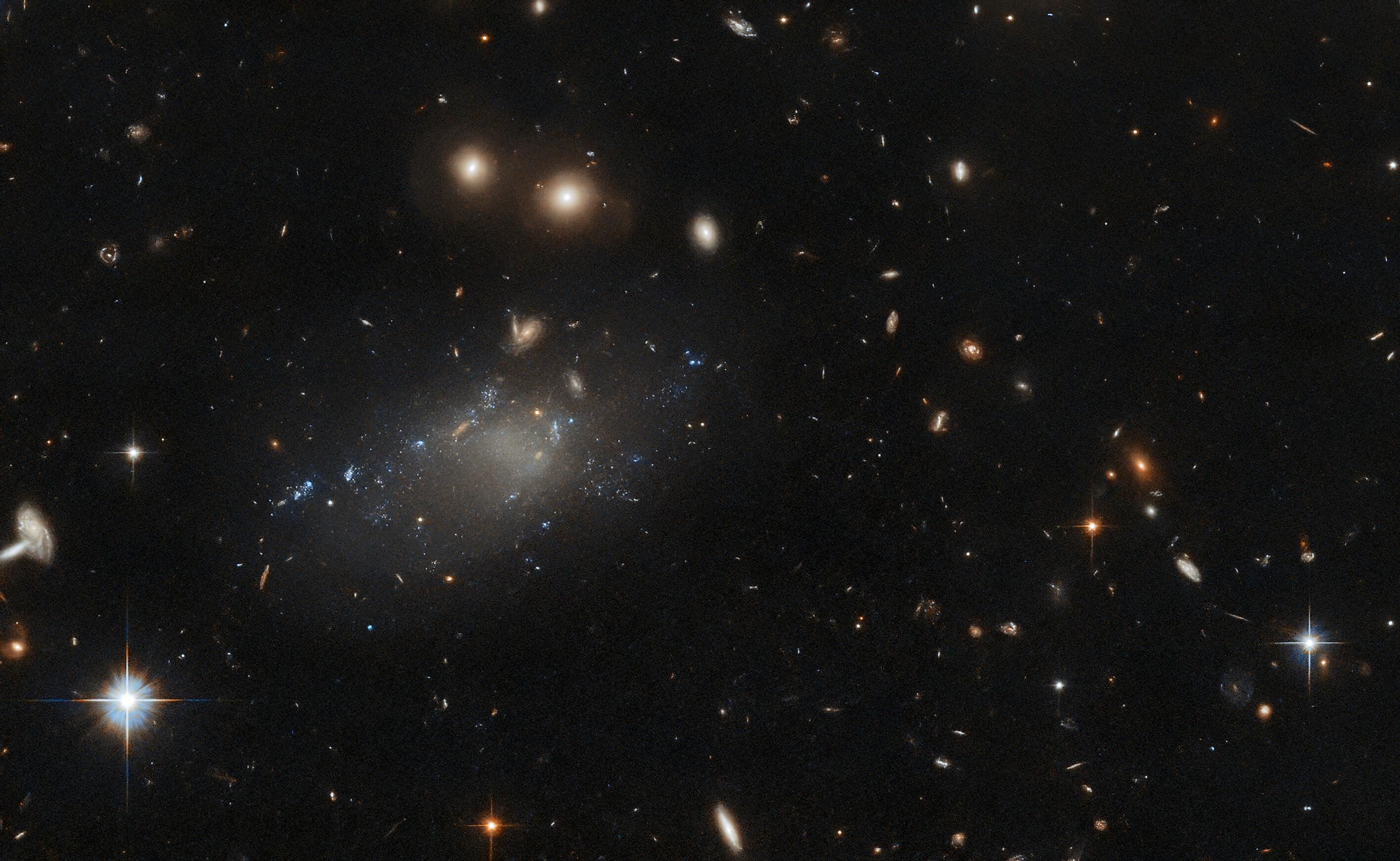
Galaxies
A galaxy is an astronomical structure containing millions to billions of stars, gas, and dust bound together by gravity. Interestingly, there is no agreed-upon definition of what a galaxy is. Even with the definition provided above, there is no distinction between a galaxy and a large star cluster. For the purpose of this discussion, we will consider the defining factor of a galaxy to be the existence of multiple generations of stars, mainly because this is something that star clusters generally lack. Thus, we can define a galaxy as an astronomical object that contains millions to billions of stars from multiple generations, all of which are bound by gravity.
Galaxies And The Great Debate

Less than a century ago, our view of the universe was radically different than it is today. Before the late 1930s, it was widely held that the universe was composed of nothing more than the Milky Way galaxy and the stars and planets contained within it. The rest of the universe was infinite and static in its expanse. Today, however, our universe picture is far different from this. We now know that the universe is not static and that it is, in fact, home to hundreds of billions, perhaps even trillions, of individual galaxies. This view of the universe first came to light in the late 1920s, when astronomer Edwin Hubble made a remarkable discovery using the Mt. Wilson Observatory. Using what was one of the most advanced telescopes at the time, Hubble sought to determine the distance to what were believed to be stellar nebulae. Nebulae are vast regions of star-forming material that exist throughout the Milky Way. Before the 1920s, astronomers thought that what we now know as distant galaxies were nebulae within the Milky Way. The nebulae that Hubble was interested in were a subject of intense debate in astronomy, as different groups of astronomers debated what precisely these objects were. Known as the "Great Debate," astronomers discussed whether or not some of these distant nebulae were other galaxies or star-forming regions within the Milky Way. Most astronomers believed they were distant nebulae contained within the Milky Way, but Hubble sought to find out indeed.
The size of our galaxy was relatively known at the time, so all Hubble needed to do was determine how far away some of these objects were. If they extended beyond the known size of the galaxy, they must be objects outside of the galaxy and thus other galaxies in and of themselves. Sounds pretty simple, right? But it's not as easy as it sounds. Knowing how far away something is in astronomy is something most of us take for granted. It hasn't always been easy. In the 1920s, determining how far away something has mainly used the method of parallax. The problem with parallax is that it doesn't allow you to determine distances beyond the Milky Way. If these objects were outside the galaxy, they could be millions of light-years away. A new technique was needed, and Hubble found just what to look for.
In astronomy, you can relate brightness and distance mathematically, and so if you know one, you can determine the other. But how do you determine brightness? There's a difference between how bright something is versus how bright it appears to be. For example, imagine placing a 5-watt light bulb a foot in front of you and an 8-watt bulb a km in front of you. To you, the 5-watt bulb is brighter. However, it only appears more radiant because it is closer to you. This type of brightness is called apparent magnitude. If you could measure their actual brightness, called absolute magnitude, you would find that despite appearance, the further bulb is, in fact, brighter. This makes it hard to determine distances in space because a bright star could be closer or further away and emit more energy. Because there are several different types of stars, this makes it all the more difficult. However, Hubble used a unique kind of star to determine distance. These kinds of stars are called cepheid variables, and they can rapidly change their energy output and brightness. However, these changes are consistent and regular, allowing astronomers to determine their absolute brightness at vast distances. These stars allowed Hubble to determine the distance to the Andromeda Nebula, which he determined to be around two million light-years. This placed it far outside the Milky Way, and thus it could not be a nebula. Instead, Hubble found that the Andromeda Nebula was, in fact, the Andromeda Galaxy. Our picture of the universe was forever changed. In a short period of time, our view of the universe changed from a small static universe containing only one galaxy to a universe that could be infinite in its expanse and is home to hundreds of billions of other galaxies. The discovery of our place in the universe is a very recent one. It was a discovery that was nearly as perspective-changing as the discovery that the Earth is but one planet in orbit around a star that is one of many in a gigantic galaxy. The universe went from finite to infinite in a matter of years. Astronomy and science were changed forever.
Spiral Galaxies
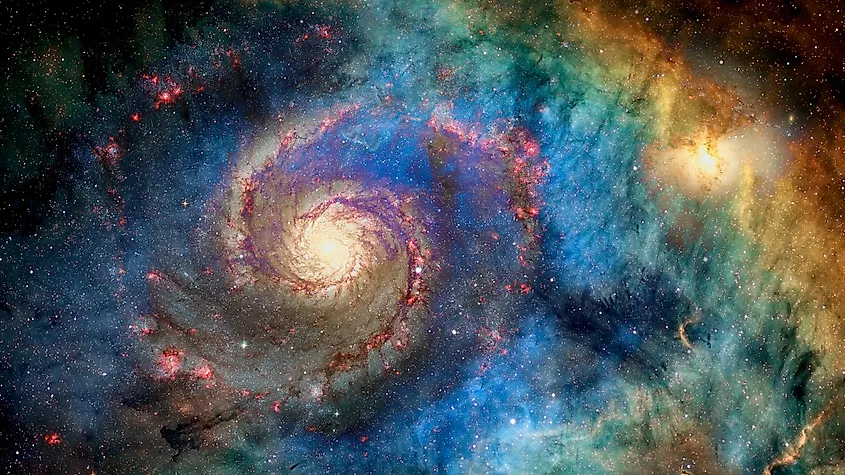
Galaxies come in a wide variety of shapes and sizes. Like snowflakes, every galaxy is unique in its way. There are four different types of galaxies: spiral, elliptical, irregular, and ring. Within each of these groups, there also exist subgroups. For example, spiral galaxies are divided into normal spirals and barred spirals. Our home galaxy, the Milky Way, is a spiral galaxy, and thus spirals are probably the most familiar type of galaxy to the general person. Spiral galaxies are the most common kind of galaxy in the universe, with spirals comprising roughly 70% of all known galaxies.
Spiral galaxies are one of nature's most brilliant sights. When observed through a small telescope, they appear as large cloudy disks, and you likely would not be able to tell the difference between a galaxy and a cloud. With larger telescopes, however, their true brilliance comes into view. Most of what is known about spiral galaxies comes from observations of our galaxy, the Milky Way. Unfortunately, we can't discern our galaxy's shape because we exist inside the Milky Way. From observations of other spiral galaxies, we know the Milky Way must also be a spiral due to physical characteristics common between all spirals. These include a central bulge of stars surrounded by a disk of stars, vast amounts of star-forming material, and the motion of stars within the galaxy.
How exactly does the spiral galaxy form? How does a group of many billions of stars end up in such a stunning shape? The complex spiral is one of nature's most beautiful creations. All you need is time and physics, along with many stars. All of the material in a spiral galaxy orbits around the galactic center. It was once assumed that the spiral shape was created because stars closer to the galactic center orbit faster than those further out. This turned out not to be the case, although something similar happened. Rather than differences in stellar velocity being the cause, it turns out that the spiral arms themselves rotate at varying speeds. When a material is exchanged between spiral arms, such as fast-moving material moving into a slow-moving arm, it hits a wall and slows down. This can compress stellar material, leading to a wave of star formation. Stars are denser than gas clouds and thus move slower than the surrounding material. Over time, stellar material moves ahead of the stars and compresses, forming more stars and continuing the process. These differences in velocity and exchanges of material create and maintain the spiral structures of these magnificent galaxies. However, this isn't actually why the galaxy becomes a spiral. The spiral arms themselves contain a much higher material density than other regions, so when gas and dust pass into a high-density region, they compress and form stars. Interestingly, the arms themselves move slower than the material within them. These changes in density create density waves that propagate through the galaxy and create a spiral shape.
Irregular Galaxies
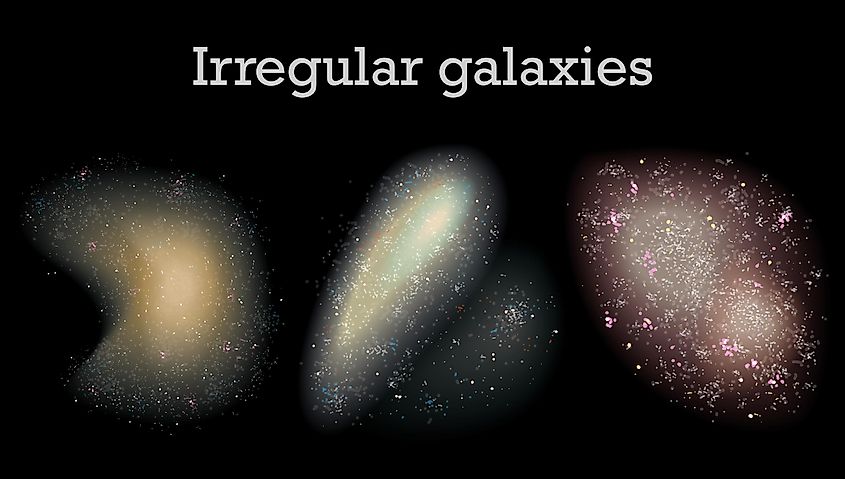
Irregular galaxies come in two types: Type 1 and 2. The primary difference between them is how similar they are to spiral galaxies. Type 1 irregulars tend to have a shape reminiscent of spirals. Like spiral galaxies, they have a central bulge of stars along with a relatively flat disk surrounding that bulge. Unlike spirals, type 1 irregulars aren't very symmetric and will generally have irregular and asymmetric shapes. It's believed that type 1 irregulars were once spirals and were likely deformed during a galactic collision. As two or more galaxies approach each other, the gravitational pull between them will distort their shape, turning what was once a spiral galaxy into a type 1 irregular galaxy. Type 2 irregulars have no discernible or defined shape. Unlike type 1 irregulars, they bear minimal resemblance to spirals, yet they too were likely formed during a galactic collision. It's possible that during a galactic collision, a spiral galaxy will likely evolve into a type 1 irregular and then into a type 2 irregular over many millions of years.
Interestingly, most irregular galaxies are relatively small, averaging around 10 billion stars each. Although this seems like a huge number, it represents only about 10% of the stars in our Milky Way. Their relatively small number of stars also makes irregulars rather dim compared to other galaxies, with only about 10% of the brightest galaxies being irregular.
Elliptical Galaxies
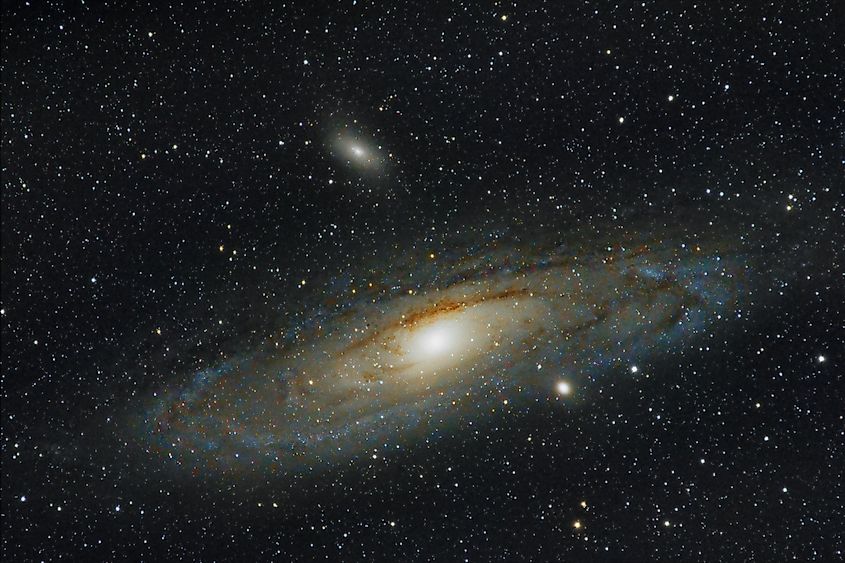
It is often said that if you see one elliptical galaxy, you have seen them all. This is because, unlike spirals and irregulars, elliptical galaxies generally only come in one shape. Every elliptical galaxy looks like a vast egg-shaped bundle of stars. Their relatively dull form may make them appear uninteresting, yet nothing could be further from the truth. Their shapes may not be unique, but elliptical galaxies are the largest galaxies in the universe. The largest known galaxy is an elliptical galaxy known as IC 1101. IC 1101 is a behemoth, measuring over six million light-years in diameter and over 100-trillion stars in mass. IC 1101 is three times larger than the distance between the Milky Way and Andromeda. How exactly does a galaxy grow to such an immense size? Simply absorb every other galaxy around you. Every large elliptical galaxy has likely undergone countless galactic mergers throughout billions of years, allowing them to grow to immense sizes. Most elliptical galaxies were probably born after a merger between two or more spiral galaxies.
Interestingly, most of an elliptical galaxy's physical characteristics can be explained by galactic mergers. In addition to their shape, galactic mergers explain why elliptical galaxies are mostly devoid of star-forming material. During a galactic merger, gravitational forces will cause most of a galaxy's star-forming material to form a vast multitude of stars. The process may last millions of years, and by the time it is finished, the galaxy will have used up most of its star-forming material. The most massive stars to form will go supernova in less than a hundred million years, and so eventually, an elliptical galaxy is left with nothing but small mass red stars.
Ring Galaxies
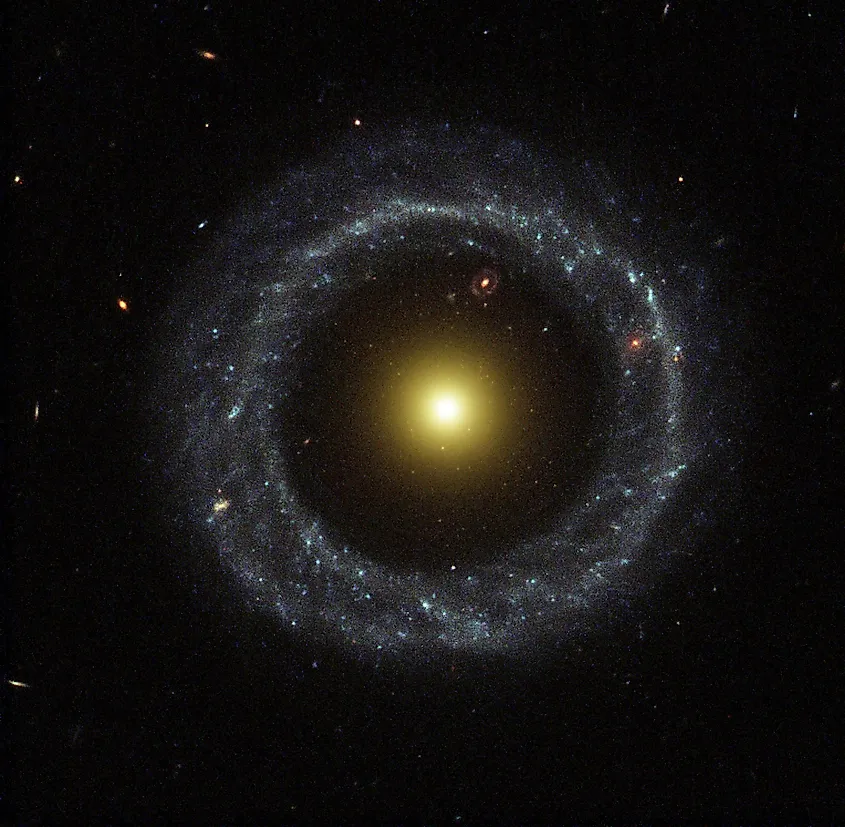
Ring galaxies are perhaps the most peculiar of all galaxies. Each ring galaxy has a central bulge surrounded by a halo of stars and nebulae. The region located between the central and outer areas is seemingly empty. Most ring galaxies have an appearance reminiscent of spiral galaxies. This is no coincidence. Most ring galaxies were likely spiral galaxies at some point during their existence. Occasionally, some of these spiral galaxies would collide in an intriguing orientation. When two spiral galaxies collide, and one happens to pass directly through the center of the other, the gravitational influence of the galaxy passing through pushes material outwards, forming a halo around a central bulge. This process also causes a wave of star formation, resulting in the outer halo containing an abundance of young, high-mass stars.
Galactic Mergers
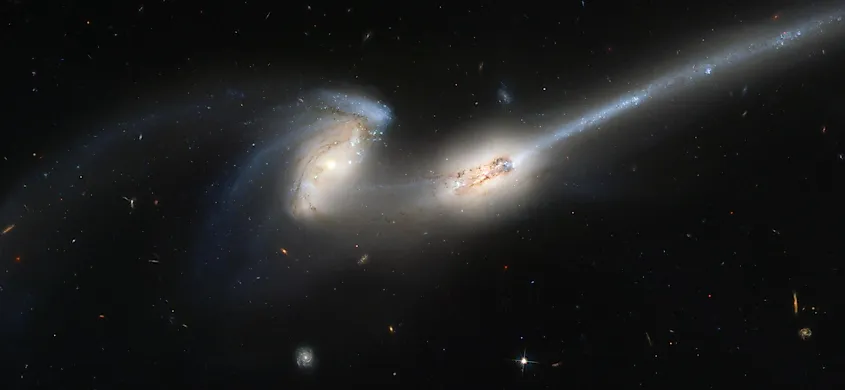
As the universe expands, most galaxies move further away from each other. However, in some cases, galaxies may approach one another and interact. When two or more galaxies move too close to each other, they begin to merge in one of the most violent and spectacular events in the cosmos. One of the most apparent observations of merging galaxies is their distorted shape due to the extreme gravitational forces. In spiral galaxies, the spiral arms may become stretched out and distorted as the gravity of the other galaxy stretches them out. A typical galactic merger may last hundreds of millions of years, and in the process, the two galaxies may become unrecognizable compared to their earlier shapes. Current models predict that the collision of two large spiral galaxies gives rise to a larger elliptical galaxy nearly devoid of star-forming material.
Interestingly, nearly every elliptical galaxy contains little to no star-forming material, while spiral galaxies are rich in stellar nurseries. Galactic mergers help to explain this observation. During a galactic merger, tidal forces from both galaxies' gravity cause stellar gas within the two galaxies to heat up and clump together, leading to an increase in star formation. It is improbable that any stars collide during the merger due to the vast distances between them. However, large nebulae may crash due to their much larger surface area. When nebulae collide, stellar material can clump together, directly increasing temperature and pressure. The collision may result in a rapid increase in star formation rate. The star formation rate is so drastic that by the time the merger is finished, most of the star-forming material is gone. This phase of rapid star birth is referred to as the starburst phase, and any galaxy within this phase is called a starburst galaxy. Things calm down after many millions of years, and a new, much larger elliptical galaxy is born.











